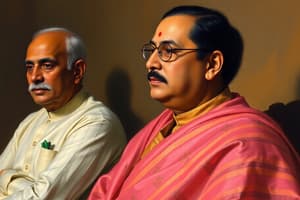Podcast
Questions and Answers
What is the primary function of the outbuf variable in the Message-Passing Model?
What is the primary function of the outbuf variable in the Message-Passing Model?
- To store the incoming messages for a processor
- To represent the physical channel directed from one processor to another (correct)
- To capture the local state of a processor
- To label the channels of a processor
In the context of the Message-Passing Model, what does a configuration represent?
In the context of the Message-Passing Model, what does a configuration represent?
- The current state of the entire system, including processor states and channels (correct)
- The specific events that can occur in the system
- The communication protocol used by processors
- The total number of processors in the network
Which statement accurately describes the processors in the Message-Passing Model?
Which statement accurately describes the processors in the Message-Passing Model?
- They interact directly through shared memory mechanisms.
- They are considered state machines with local state variables. (correct)
- Each processor can know all other processors in the system.
- Processors can only send messages but not receive them.
What is true about events in the Message-Passing Model?
What is true about events in the Message-Passing Model?
How are channels represented in the Message-Passing Model?
How are channels represented in the Message-Passing Model?
What does the variable inbuf correspond to in a processor?
What does the variable inbuf correspond to in a processor?
Which of the following accurately characterizes the mechanism of labeling incident channels at a processor?
Which of the following accurately characterizes the mechanism of labeling incident channels at a processor?
How are the processors in a network indexed?
How are the processors in a network indexed?
What characterizes a 'winner' in the leader election algorithm?
What characterizes a 'winner' in the leader election algorithm?
How is the maximum number of phase k - 1 winners determined?
How is the maximum number of phase k - 1 winners determined?
What does the phrase 'at each phase the number of winners is cut approximately in half' imply?
What does the phrase 'at each phase the number of winners is cut approximately in half' imply?
How many phases are required to conclude the leader election process?
How many phases are required to conclude the leader election process?
How does the total number of messages in the leader election algorithm scale?
How does the total number of messages in the leader election algorithm scale?
Why is the O(n log n) algorithm considered better in terms of message complexity than the O(n^2) algorithm?
Why is the O(n log n) algorithm considered better in terms of message complexity than the O(n^2) algorithm?
In what scenario can we not further reduce the number of messages beyond O(n log n)?
In what scenario can we not further reduce the number of messages beyond O(n log n)?
What is the relevance of O(n log n) in the context of leader election algorithms?
What is the relevance of O(n log n) in the context of leader election algorithms?
What is the message complexity of a leader election algorithm in asynchronous rings whose size is not known a priori?
What is the message complexity of a leader election algorithm in asynchronous rings whose size is not known a priori?
In synchronous networks, what is the message complexity achievable if general arithmetic operations are allowed?
In synchronous networks, what is the message complexity achievable if general arithmetic operations are allowed?
What is the message complexity for leader election in synchronous rings under certain conditions?
What is the message complexity for leader election in synchronous rings under certain conditions?
What type of algorithms are LCR and HS in the context of leader election?
What type of algorithms are LCR and HS in the context of leader election?
How does message complexity change for synchronous rings when conditions are not met?
How does message complexity change for synchronous rings when conditions are not met?
What aspect of leader election algorithms is evaluated according to the provided content?
What aspect of leader election algorithms is evaluated according to the provided content?
What is the expected message complexity of leader election in an asynchronous ring with known size?
What is the expected message complexity of leader election in an asynchronous ring with known size?
What will be discussed in the upcoming lecture following this one?
What will be discussed in the upcoming lecture following this one?
What is the primary goal of the leader election problem in message-passing systems?
What is the primary goal of the leader election problem in message-passing systems?
Which condition must hold true in an admissible execution of the leader election problem?
Which condition must hold true in an admissible execution of the leader election problem?
What type of topology is specifically discussed regarding the leader election problem in this lecture?
What type of topology is specifically discussed regarding the leader election problem in this lecture?
What is NOT a use of a leader in a leader election system?
What is NOT a use of a leader in a leader election system?
What happens to a processor once it enters an elected state in the leader election problem?
What happens to a processor once it enters an elected state in the leader election problem?
How can the leader election problem assist in resolving deadlocks among processors?
How can the leader election problem assist in resolving deadlocks among processors?
Which variant is NOT mentioned as part of the leader election problem's classification?
Which variant is NOT mentioned as part of the leader election problem's classification?
Which statement about the elected and not-elected states in the leader election problem is correct?
Which statement about the elected and not-elected states in the leader election problem is correct?
What is meant by 'uniform algorithms' in the context of ring processing?
What is meant by 'uniform algorithms' in the context of ring processing?
What is the function of the LCR algorithm in a ring network?
What is the function of the LCR algorithm in a ring network?
How do processor ids differ from indices in the context of ring algorithms?
How do processor ids differ from indices in the context of ring algorithms?
What describes the time complexity of the O(n^2) leader election algorithm?
What describes the time complexity of the O(n^2) leader election algorithm?
What happens when a processor receives an id that is greater than its own in the LCR algorithm?
What happens when a processor receives an id that is greater than its own in the LCR algorithm?
Which of the following statements is NOT true about the message complexity of the leader election algorithm?
Which of the following statements is NOT true about the message complexity of the leader election algorithm?
In what scenario does a processor elect itself in the LCR algorithm?
In what scenario does a processor elect itself in the LCR algorithm?
What defines a 'non-uniform algorithm' in the context of leader election?
What defines a 'non-uniform algorithm' in the context of leader election?
Flashcards are hidden until you start studying
Study Notes
Leader Election (LE) Problem
- Leader election is necessary for a group of processors to choose one as the leader.
- It is vital in preventing deadlocks by breaking symmetry in processor interactions.
- Each processor must decide whether to become the leader or remain a non-leader with exactly one elected leader.
Processor Communication Model
- Processors communicate via bidirectional, point-to-point channels.
- The system comprises n processors, with each one having its own local state and mechanisms for modeling channels.
- Events in the system are represented as occurrences that can modify the state.
O(n log n) Leader Election Algorithm
- The algorithm proceeds in phases where processors identified as "winners" in one phase participate in the next.
- Maximum number of phase winners at phase k-1 is approximately n/(2k-1 + 1), focused on maximizing density.
- After roughly log2 n phases, only one winner remains, with the maximum phase being ⌈log(n–1)⌉ + 1.
- Total message complexity across phases is O(n log n), primarily due to winners generating messages that are propagated through the network.
Comparison with O(n²) Algorithm
- The O(n log n) algorithm is more efficient than the O(n²) LCR (LeLann-Chang-Roberts) algorithm, despite needing fewer messages.
- The LCR algorithm functions by sending the processor’s ID to the left and making decisions based on comparisons with incoming IDs.
- Message complexity of the LCR algorithm can reach n, as IDs travel to determine the leader.
Types of Rings and their Algorithms
- Algorithms differ in performance based on ring topology: anonymous/non-anonymous and uniform/non-uniform designs.
- In asynchronous rings, any leader election algorithm has a minimum message complexity of Θ(n log n).
- In synchronous rings under certain conditions, message complexity may drop to Θ(n).
Model Characteristics
- Each processor has a unique identifier (ID), which is crucial for comparisons in leader election.
- Uniform algorithms operate independently of the ring size, while non-uniform algorithms do not.
- Each selected algorithm is subject to the structure of the ring and the properties (synchronous or asynchronous) of the communication network.
Uses of Leader Election
- A designated leader coordinates system activities, including managing tokens and ensuring efficient communication.
- Leader election serves as a fundamental element in strategies for spanning tree generation and fault recovery in networks.
Future Topics
- Upcoming discussions will cover models of distributed computation, causality in distributed systems, and frameworks for logical clocks.
Studying That Suits You
Use AI to generate personalized quizzes and flashcards to suit your learning preferences.




